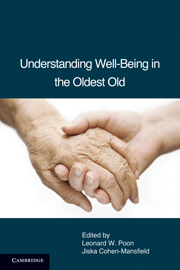Book contents
- Frontmatter
- Contents
- List of Tables
- List of Contributors
- Foreword by Carol D. Ryff
- PART I THEORY: NEW HORIZONS IN WELL-BEING RESEARCH
- PART II PARADISE LOST: BETWEEN TRAUMA AND HAPPINESS
- PART III PATHWAYS AND GATEKEEPERS: MODERATING, MEDIATING, AND PROXIMAL PROCESSES
- 9 Impact of Resources on Successful Adaptation among the Oldest Old
- 10 Nutrition and Well-Being
- 11 Cognitive Functioning and Vitality among the Oldest Old: Implications for Well-Being
- 12 Social Relationships and Well-Being in Very Late Life
- 13 Spirituality and Religiosity Connections to Mental and Physical Health among the Oldest Old
- 14 The Impact of Leisure Activity and Innovation on the Well-Being of the Very Old
- PART IV SIGNPOSTING PARADISE: MEASUREMENT OF WELL-BEING
- Index
- References
11 - Cognitive Functioning and Vitality among the Oldest Old: Implications for Well-Being
Published online by Cambridge University Press: 05 August 2012
- Frontmatter
- Contents
- List of Tables
- List of Contributors
- Foreword by Carol D. Ryff
- PART I THEORY: NEW HORIZONS IN WELL-BEING RESEARCH
- PART II PARADISE LOST: BETWEEN TRAUMA AND HAPPINESS
- PART III PATHWAYS AND GATEKEEPERS: MODERATING, MEDIATING, AND PROXIMAL PROCESSES
- 9 Impact of Resources on Successful Adaptation among the Oldest Old
- 10 Nutrition and Well-Being
- 11 Cognitive Functioning and Vitality among the Oldest Old: Implications for Well-Being
- 12 Social Relationships and Well-Being in Very Late Life
- 13 Spirituality and Religiosity Connections to Mental and Physical Health among the Oldest Old
- 14 The Impact of Leisure Activity and Innovation on the Well-Being of the Very Old
- PART IV SIGNPOSTING PARADISE: MEASUREMENT OF WELL-BEING
- Index
- References
Summary
ABSTRACT
This chapter clarifies and differentiates changes in cognitive functioning among the oldest old at the group and individual levels. Cross-sectionally, the oldest old demonstrate normative differences of being more physically and cognitively frail compared to younger groups. More variation and successful aging is observed at the individual level. Some oldest-old individuals can perform at the same levels as adults 20 to 40 years younger. Recent literature has recognized that the concept of cognitive vitality transcends the absence of dementia or dementing processes. We seek to clarify the concept of cognitive vitality because it has not been well defined in the literature either theoretically or operationally. This chapter addresses the following questions: 1) What is cognitive vitality and how does it contribute to the well-being of older adults? 2) What factors or resources contribute to cognitive vitality among the oldest old? and 3) What new directions can be identified for future research?
COGNITIVE FUNCTIONING AND VITALITY AMONG THE OLDEST OLD: IMPLICATIONS FOR WELL-BEING
Lay people and professionals alike fall prey to aging stereotypes and myths (Ory, Hoffman, Hawkins, Sanner, & Mockenhaupt, 2003), namely that cognitive decline is inevitable and there is nothing we can do about it. Empirical research has focused on comparing the cognitive performance of younger and older adults, often noting “deficits” in older adults' abilities without taking into account context and potentially meaningful qualitative differences in older adults' approaches to cognitive problems (e.g., Marsiske & Margrett, 2006).
- Type
- Chapter
- Information
- Understanding Well-Being in the Oldest Old , pp. 186 - 212Publisher: Cambridge University PressPrint publication year: 2011



